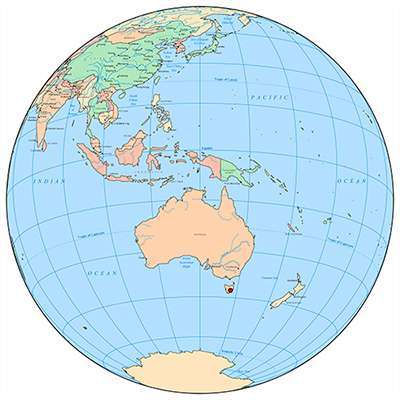 It has been 29 years since I was last in Hobart, and 44 years since I moved to the mainland. People on the mainland are often bemused that Tasmanians call it that, like it’s some weird chip that islanders have on their collective shoulder. But it’s really just a practical term, like the difference between “the bush” and “the big smoke”.
It has been 29 years since I was last in Hobart, and 44 years since I moved to the mainland. People on the mainland are often bemused that Tasmanians call it that, like it’s some weird chip that islanders have on their collective shoulder. But it’s really just a practical term, like the difference between “the bush” and “the big smoke”.
I grew up in Claremont, in the northern suburbs of what is technically the City of Glenorchy, and spent my college years and a couple more thereafter living in the southern suburbs close to the CBD of Tasmania’s capital. It was and remains the biggest smoke there is in Tasmania. I knew it well, and I will always think of it as my hometown – or one of them, at least. The last time I was in Hobart was for my father’s funeral in 1994.
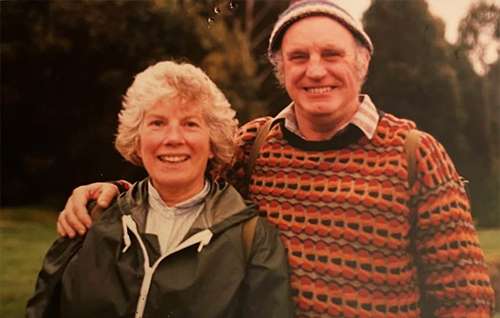 The spur for me to visit again was another passing – two of them, the parents of a couple of friends to whom I became very close. Jean and Bernard Pidd were champions of the theatre in Hobart: mainstays of the Hobart Repertory Theatre Society, frequently on stage themselves at The Playhouse, veterans of theatre restaurants, musicals, and stages big and small.
The spur for me to visit again was another passing – two of them, the parents of a couple of friends to whom I became very close. Jean and Bernard Pidd were champions of the theatre in Hobart: mainstays of the Hobart Repertory Theatre Society, frequently on stage themselves at The Playhouse, veterans of theatre restaurants, musicals, and stages big and small.
They were also incredibly supportive of anyone who wanted to engage with theatre, including me.
I can safely say that, if not for the very active encouragement they gave me, the practical advice and the exceedingly generous way they welcomed me into their home and family, I would never have become an actor myself and stepped on to the various pathways I then took in my life.
So, when I learned that there was to be a memorial celebration in Hobart on the 8th of June of the life of Jean and Bernard, after they had passed away in March this year and 2021 respectively, my decision was instant and obvious to me: “I’ll be there”.
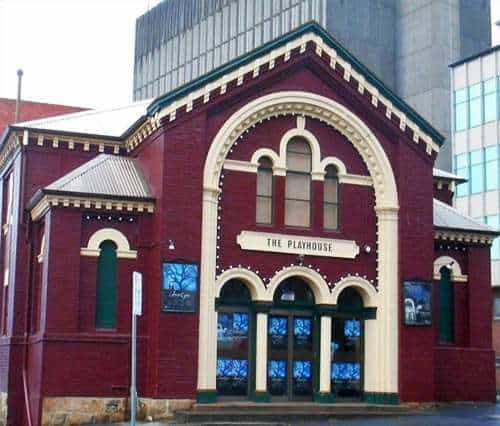 The celebration was to take place at The Playhouse theatre, their home away from home, and the place where I went to my very first audition for a role. My Speech & Drama teacher at Hobart Matric had suggested I try out for a part in an upcoming play as she felt I had some talent for performing.
The celebration was to take place at The Playhouse theatre, their home away from home, and the place where I went to my very first audition for a role. My Speech & Drama teacher at Hobart Matric had suggested I try out for a part in an upcoming play as she felt I had some talent for performing.
I turned up and very nervously let Jean know that I would like to audition for the role of the Young Policeman in their next play (I can’t remember what it was). I could see her talking to a youth my own age, and looking at me. That was her son, Ian, and I’m pretty sure she was telling him to go over and say hello and make me feel welcome.
Ian did come over and, after briefly welcoming me to the auditions, let me know in a not unfriendly but very clear and determined way that he was auditioning for the same part, and that he was going to get it.
OK. Welcome to Rep. I thought my audition went pretty well, but Ian had much more experience than me and was far more comfortable on the stage. He did win the role, and I congratulated him, and that was the start of a friendship that has lasted through the many years – probably at it strongest when we shared a house together in the early 80s in Sydney’s Surry Hills, sometimes attenuated by the distances between us as we moved around the country, but always firm in a shared understanding and liking for each other.
Ian left Hobart in 1979 to study acting at The Drama Studio in Sydney and, when I later moved there to work as an actor myself, we had the fortune to work together in an experimental theatre piece for D’Arc Swan. I did manage to accidentally hit him in the head with an axe during one performance, but our friendship survived.
Before that, though, I had a truly life changing experience in Hobart. Having dropped out of a teaching degree, I spent a year working the Tax Office, when another bloke who became a lifelong friend, Adam Newcombe, held a series of clowning workshops. Clowning was something I was deeply and seriously interested in, as was Adam, and we spent many hours talking about the theories of this ancient and very particular form of performance art. His workshops were a delight for me, and probably the first time I felt truly confident as a performer, developing a clown persona I was able to inhabit with complete abandon.
There were people in those workshops who went on to do wonderful things in theatre and other performance arts, but what turned my world around was when an internationally experienced mime artist called Michael Freeland, himself a Tasmanian, got wind of what we were doing and invited us to do some mime workshops with him. The association between mime and clowning is very close and, again, I felt I was stepping into a world that was made for me (the reasons for that would only become clear to me much later).
Michael was, and I imagine still is, a very dynamic, enthusiastic and self-driven person, whose boldness and self belief led him to an international performance career. He not only shared his mime skills with us, but had us breathing fire, juggling and walking both tight and slack ropes. I can’t quite remember where in the process it came up, but at some point Michael said we should form our own performance troupe: put together a show, get a van and take to the road.
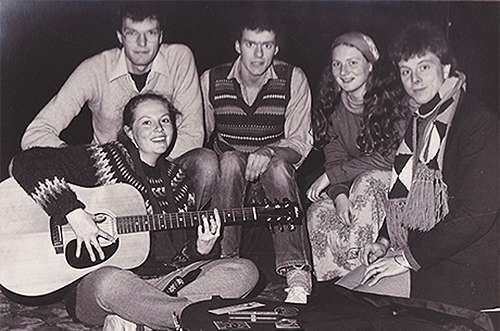 This was the stuff of fantasy, surely! But Michael was as practical as he was a dreamer, and he somehow convinced five of us to give up whatever work or study we were involved with, seek some funding and start our own company.
This was the stuff of fantasy, surely! But Michael was as practical as he was a dreamer, and he somehow convinced five of us to give up whatever work or study we were involved with, seek some funding and start our own company.
Once Adam grew enthused and said he had some ideas for a skit based show we could offer to schools as theatre-in-education, I and Mary Louise (Cabbage) Thorp were ready to quit our Tax Office jobs, Penny McDonald signed on, and we were joined by Ian’s brother David Pidd.
TUK was an idea right for its time, pulling together mime, puppetry, clowning, juggling, and songs with just enough of a theme of sharing and co-operation to qualify as educational, at a time in the 1980s when in-school performance was going through a boom period (it’s always mystified me why that boom died out, but that’s another story). True, after 8 months we did run out of schools to perform to and, frankly, the energy required to keep going, but the members of TUK have all remained lifelong friends to me. And I went to the big smoke on the mainland to work in theatre-in-education for another seven years.
What better time and reason, then, to revisit in 2023 the city of my youth than to celebrate the lives of two of the people who did more to get me into a life in theatre than just about anyone, along with two of their offspring who were some of my closest friends and colleagues?
So, to Hobart.
Working in IT and web tech as I have for more than 30 years now, I arranged my trip online, booking myself in to the Allurity Hotel because it’s right next to the Playhouse in Bathurst St, and across the road from the New Sydney Hotel, where there would be drinks after the memorial.
I was somewhat surprised on the bus ride from Hobart Airport into the city to see how dry and brown everything was. The area around Corrimal and along the train ride to Sydney Airport had been lush and green, as it usually is in winter, and I’d expected Tasmania to be much the same. Maybe I’d just forgotten how it really looked.
The airport bus had six drop-off points around the Hobart CBD and mine was the second last, so I had a gratis tour of the city on my way to the hotel. As a reminder of how small Hobart is, the whole loop took a mere 10 minutes, but it did give me the chance to glance at a few key landmarks from the bus window: the docks, Franklin Square, St David’s park and the cathedral, the repat hospital where I’d visited my father after one of his heart attacks, the Collegiate pool where I was first taught that swimming was not for me … the memories came, um … flooding back.
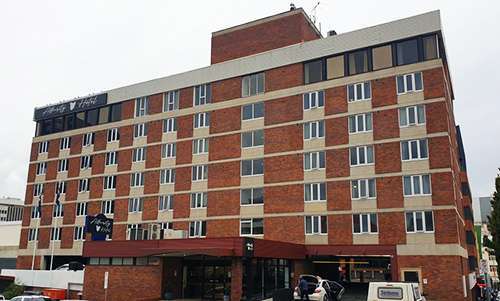 My next surprise was to realise that the Allurity Hotel was, in fact, what had been in my day the Downtowner, then part of the Four Seasons chain that included the Townhouse Hotel where I’d worked as a waiter and undertaken a silver service waiter’s course.
My next surprise was to realise that the Allurity Hotel was, in fact, what had been in my day the Downtowner, then part of the Four Seasons chain that included the Townhouse Hotel where I’d worked as a waiter and undertaken a silver service waiter’s course.
The Downtowner had had a basement bar called the Hideaway, where the local new wavers, goths, and various other insiders/outsiders came on weekends to dress up and dance, to which I was introduced by Cabbage.
It was the first place I felt even vaguely comfortable dancing, crammed on to a tiny dance floor until closing time. I was later told the bar itself still exists but boarded up, hidden away for good, it seems.
I unpacked and set up my work laptop, checked my messages (not many, as most of my online colleagues in the UK and US were not yet up and about) and got myself ready to meet Terese, my late brother Harry’s first wife, for afternoon tea. She knew a lovely bakery near the waterfront and it was warm enough to sit outside while we caught up on several decades of not having seen each other, mostly talking family.
After Terese dropped me back at the hotel, I ventured out to a supermarket and bottle shop to get some supplies. The Woolworth’s was like any Woolworth’s but I got another surprise at the bottle shop. I wanted to buy a bottle of cheap wine to take back to my room, but they all seemed very expensive. I told the sales assistant, “I’m hoping for a bottle of pinot noir under $20, or am I in the wrong shop for that?” The reply was a dry, “You’re probably in the wrong STATE for that!” So I ended up with a not-so-cheap bottle of wine and a flask of even-less-cheap Scotch, the nearest thing to Jameson they had.
By this time, it was 5pm and getting dark, as it does in those parts in winter, and I did a couple of hours of work, answering some queries from accessibility engineers about the finer details of making websites and apps accessible to people with disabilities.
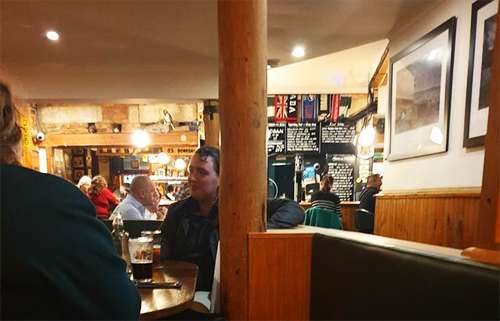 I could see the New Sydney from my window and even from the top floor it looked very warm and inviting, so I went into the bustling front bar and ended up having an enormous meal of fish and chips with a pint of lager. It was a very different pub to when I’d last been there.
I could see the New Sydney from my window and even from the top floor it looked very warm and inviting, so I went into the bustling front bar and ended up having an enormous meal of fish and chips with a pint of lager. It was a very different pub to when I’d last been there.
Now, it’s a wood lined British style pub with a roaring fire, flags and a boisterous crowd chatting and laughing at the bar and tables. In 1978, it was a very ordinary suburban pub with formica tables and metal chairs in the front bar, and a Ladies Lounge out the back.
I’d been there for a meeting with Josh Morgan and Mark Lyons-Reid. Josh was an Irish Australian cabaret singer who’d had great success the previous year with his tribute song to the recently deceased Elvis Presley, “Here’s To The King”. It had been a big hit in several countries and spurred Josh into making more recordings, including a version of “The Town I Loved So Well” on which I played guitar. It, too, was a hit and went to number one in Germany and Ireland (the latter even more surprising as the song was about Derry in Northern Ireland).
We were meeting with Mark, a veteran of the Hobart stage in the style of the classic British actors, who could declaim like Gielgud or Richardson and command a stage like few others, to discuss a spoken word version of the Kris Kristofferson song “Jody And The Kid”, a particularly sentimental piece of schmaltz. This did, in fact, get made and I have still the cassette to prove it!
Mark was also fond of wine and was known to have appeared quite inebriated before taking the stage and performing for all the world as if he was sober as a judge. On this occasion, at the pub before noon, I was saddened to see him perform the old trick of tying his necktie to one wrist, looping it around his neck and pulling on it with his free hand to raise a wineglass to his mouth. Josh and I were both dismayed but said nothing.
So, that was my last memory of the New Sydney, a sobering one to bring to such a convivial scene in 2023. I went back to my room and did some more work as my colleagues logged on, then had a couple of glasses of wine and an early night.
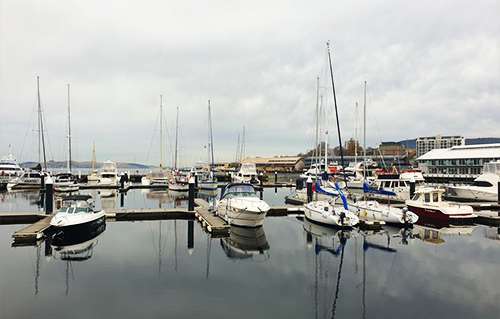 The next morning, I had breakfast in my room from my supermarket supplies and headed out to explore Hobart anew.
The next morning, I had breakfast in my room from my supermarket supplies and headed out to explore Hobart anew.
Inevitably, my feet took me down to the waterfront and I spent a good couple of hours just hanging around what is really one of Hobart’s strongest points, a real working harbour five minutes from the CBD.
It was a magical place to me in my childhood and youth and it’s still the same to me now. I can’t think of many places where fishing boats and sleek yachts mingle in such a way at the doorstep to a city.
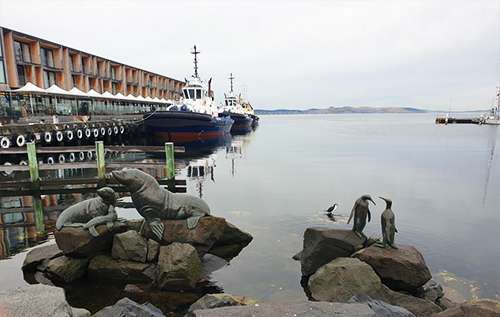 Constitution Dock (where the entrants in the Sydney to Hobart Yacht Race end up each year) and Victoria Dock (where when I was 11 or 12 my cousins and I would come to hang over the piers and fish for mullet with bread as bait or try to foul hook silver trevally) shimmered gloriously.
Constitution Dock (where the entrants in the Sydney to Hobart Yacht Race end up each year) and Victoria Dock (where when I was 11 or 12 my cousins and I would come to hang over the piers and fish for mullet with bread as bait or try to foul hook silver trevally) shimmered gloriously.
The long piers jutting out into the Derwent seem to have all been converted into apartments and restaurants, but they still had plenty of patient anglers with buckets spaced out along them, dropping handlines between the moored tugboats and enjoying the overcast but mild morning air.
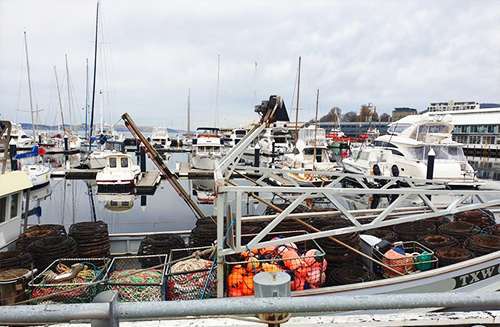 Luxury yachts and fancy cruisers were docked alongside smaller fishing boats stacked with cray pots, lines and plastic tubs. Sightseeing tours had their A-framed signs out along the footpath, and over on the Franklin Pier sat two artfully decorated ferries ready to take people to MoNA up the river.
Luxury yachts and fancy cruisers were docked alongside smaller fishing boats stacked with cray pots, lines and plastic tubs. Sightseeing tours had their A-framed signs out along the footpath, and over on the Franklin Pier sat two artfully decorated ferries ready to take people to MoNA up the river.
I remembered the times when my family would come into the city at night to watch the first of the Sydney to Hobart boats come in, their arrival over the years occurring earlier and earlier in the day as the course records were broken year after year by increasingly large maxi yachts.
Eventually, I strolled south along the waterfront, passing the fenced-in Winter Feast that was due to start that night as part of the Dark Mofo festival. It was certainly a hive of activity but looked like quite a lot yet needed to be done.
And thus to Salamanca Place, site of so many memories. My first ever job was in the early 70s on a book stall at Salamanca Market on Saturday mornings. My brother Harry had worked out that when bookshops order books in, there’s always a few extra in case of damages in transit. Somehow, Harry had made a deal with one or more bookshops or publishers that he would get the “overs” and sell them at the market at prices lower than in the bookshops – they were effectively free, after all, any price was all profit.
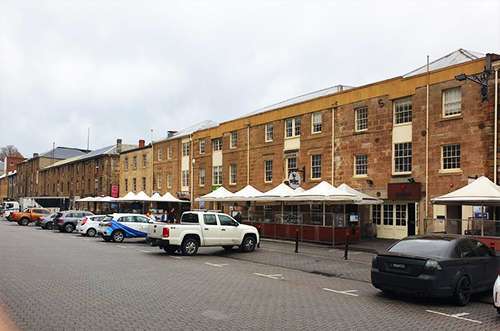 I was paid $20 for about three hours work, which was a pretty good deal as all I had to do was stand around and take buyers’ money.
I was paid $20 for about three hours work, which was a pretty good deal as all I had to do was stand around and take buyers’ money.
The stall always did good business and it was a great atmosphere. All the stall holders looked after each other, and the customers were usually friendly tourists as well as locals who came for the fresh fruit and vegetables.
Afterward, I used to spend some of my wages at a cinema before bussing back to Claremont.
When I was a bit older, I started busking at the same market, sometimes just me and my guitar, sometimes with one or more others who could sing better than me. Despite being a rubbish singer, I sang a lot, getting myself a regular gig at the St Ives Hotel in Sandy Bay, and hooking up with college friend John Coleman and his friend Peter Hasenkam to form what eventually became the band Fern Chutney. It was at the Governor’s Retreat pub on Salamanca Place that one Anzac Day that John and Peter played and sang a rendition of “And The Band Played Waltzing Matilda” that had everyone in tears.
Salamanca was also where Michael Freeland taught us the skills to form TUK, and where our company had its office in one of the warren of old warehouse spaces. It was, and still is, Hobart’s arts precinct, with other arts companies, craft shops and performing spaces littered throughout. It was in the TUK office on a fateful day in late 1980 that we decided to fold the company, the same day I realised my precious Maton guitar had been stolen, and the same day I found out my mother had died.
Standing there now, in 2023, all the memories came surging back. It sill looks the same, with maybe a few more cafes and architects’ offices.
And then on into the heart of the city. I had expected that there would be a lot of changes in my near 30 years away but, honestly, not that much has changed. Unlike Sydney, where old buildings have been torn down to be replaced by towers of glass and steel, Hobart’s skyline remains largely the same. The buildings have new tenants, awnings and paint jobs but they’re still mostly the same buildings.
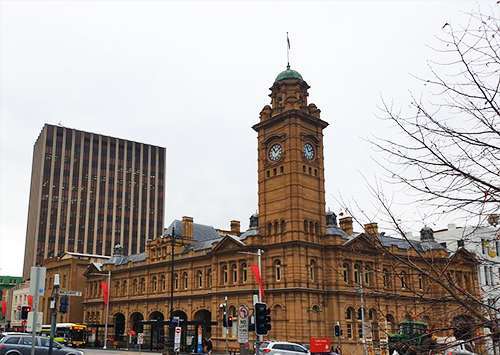 The highest building in town, apart from a recent addition to the Royal Hobart Hospital, is still the AMP Building near the Post Office. It’s now NAB House but it’s still only 14 floors high, the same as it was when it was opened in 1968.
The highest building in town, apart from a recent addition to the Royal Hobart Hospital, is still the AMP Building near the Post Office. It’s now NAB House but it’s still only 14 floors high, the same as it was when it was opened in 1968.
Apparently that goes for the whole state. The tallest building in Tasmania is still Wrest Point Casino, which opened in 1972. I don’t know if this is the result of a deliberate policy of restraint but I heartily approve. It means Hobart has avoided the sunless, windy canyons that characterise much of the Sydney CBD these days.
There are changes, of course. The Cat & Fiddle Arcade is a lot more crowded than it used to be, its central circular plaza filled with food stalls, tables and chairs. But the clock is still up on the main wall (I always thought it was more of a cello than a violin), and the rhyme is still played out on the hour by the mechanical display. There’s a different coffee shop where the one I’d meet girls used to be, but it looked like the clientele was still mostly high school students, just a newer generation.
The mall has nicer seating these days and a few artistic animal statues for decoration, but not that much has changed. Walking up Liverpool St, I couldn’t see Allan’s any more (where I’d bought the aforementioned Maton for $320 – that CW80D/6 model sells for 10 times that amount now), nor Glasser & Parker (where I bought my first and, to date, only suit I ever owned).
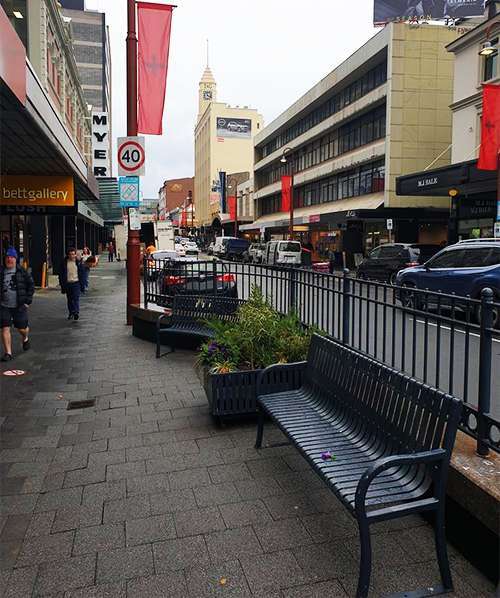 Cinema One no longer operates out of its downstairs venue in Murray Street, the one a group of us danced out of and all over the street after watching “Fame”. But Hadley’s Hotel is still there, further up the street, then (and still, I believe) a great venue for jazz and one of the few late openers in Hobart in the 70s.
Cinema One no longer operates out of its downstairs venue in Murray Street, the one a group of us danced out of and all over the street after watching “Fame”. But Hadley’s Hotel is still there, further up the street, then (and still, I believe) a great venue for jazz and one of the few late openers in Hobart in the 70s.
Hadley’s main hall was the venue for a big party in 1979 to promote the opening of the movie “Love At First Bite”, an event for which I was hired to dress up as Dracula, with full makeup, costume and Transylvanian accent (a promotion that worked so well I was hired to do it all again in Launceston, Devonport and at the Burnie Show, as well as in newspapers and on TV and radio). The Hadley’s party was attended by appropriately costumed members of the Tasmanian Puppet Theatre, including a chap called Adam Newcombe with whom I immediately clicked.
Fuller’s Bookshop seems to have moved to bigger premises further up Collins Street than it used to be, and it’s a much bigger enterprise than when I would spend hours there.
The State Library is still where it’s always been, another place I’d spend hours before checking out books, magazines and records that changed my life.
And over it all still looms Kunanyi, known only as Mt Wellington in my day, with its cliff face known as the organ pipes and its hairpin bending road to the top. I believe there’s more up there than boulders, a weather station and media transmission towers these days, and there’s ongoing debate about whether there should be a cable car to the peak. But it still sits there, often shrouded in clouds, and sometimes with a dusting of snow on top.
The memorial itself was all kinds of wonderful. I sat with Penny, who I hadn’t seen in many years and who was as warm and funny and loving as ever. In front of us sat Noreen Le Mottee, who has been in just about everything theatrical ever made in Hobart (we were both in the movie Slippery Slide, but I worked more closely with her in a corporate video for a retirement village – she was the CEO and I was, rather hilariously, the “soul” of the centre: a ghostly spectre who appeared to remind the staff of the importance of their job).
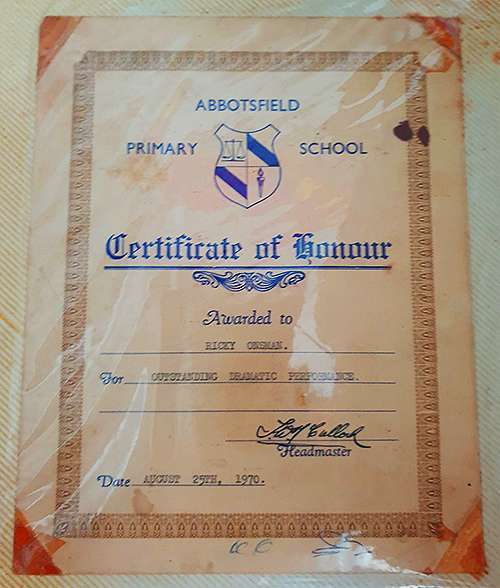 As I said hello to Noreen, the gentleman next to her turned around and said, “Ricky Onsman? I taught you in Grade 6 at Abbotsfield Primary”. Good Lord! I knew there would be some memories rekindled, but I really hadn’t expected them to go back that far! In some ways, my last two years at Abbotsfield were the peak of my academic career. I’d done so well in my early years that I skipped Grade 4. I came into my own in Grade 5, lucky to have been at a small school where I could thrive.
As I said hello to Noreen, the gentleman next to her turned around and said, “Ricky Onsman? I taught you in Grade 6 at Abbotsfield Primary”. Good Lord! I knew there would be some memories rekindled, but I really hadn’t expected them to go back that far! In some ways, my last two years at Abbotsfield were the peak of my academic career. I’d done so well in my early years that I skipped Grade 4. I came into my own in Grade 5, lucky to have been at a small school where I could thrive.
In Grade 6, I was awarded two Certificates of Honour, for Outstanding Academic Achievement and Outstanding Dramatic Performance. School-wise, everything after that went downhill. Claremont High knocked a lot out of me, I didn’t take Hobart Matric nearly seriously enough and I made a complete mess of TCAE. Most of the education and training I’ve had since has been “informal” at best.
Abbotsfield Primary no longer exists, which is sad, and nor does Claremont High, which isn’t. I’ve since connected with my Grade 6 teacher, Rod Gray, on Facebook and look forward to keeping in contact.
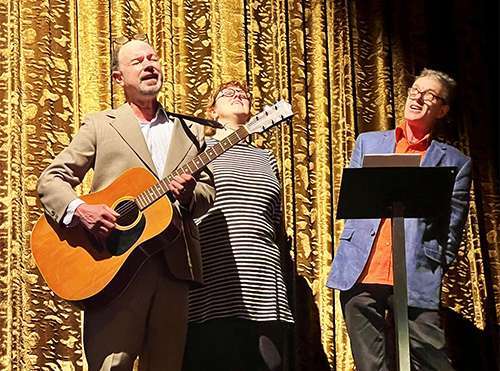 Meanwhile, in the here and now at The Playhouse, Ian and David led us through songs and memories of their Mum and Dad, who were present in the form of their ashes, centre stage.
Meanwhile, in the here and now at The Playhouse, Ian and David led us through songs and memories of their Mum and Dad, who were present in the form of their ashes, centre stage.
With Ian on guitar and ukulele, they were accompanied by Dean Stevenson on double bass, and Ian’s daughter Rosie joined them at one point. (I pinched the photo from Richard Bladel on Facebook.)
Ian and Noreen duetted on a couple of songs. Both Ian and Davo told us some lovely stories, and we all joined in on a few music hall classics. As Ian remarked later, Jean and Bernard would have loved it.
I couldn’t help recalling their wonderful house in Battery Point, where they made me feel completely at home, even as I was intimidated by how well everyone could sing. More or less forced to join in, I would sing very quietly among those amazing harmonies. These days, it staggers me to think I would sing solo at a pub, let alone the busking and singing in many of the theatre shows I was in later. People really are very tolerant.
Post-memorial, it was back to the New Sydney for drinks, where I caught up with some old friends and made some new ones. I wish I’d been able to chat more with many, such as Dave Byrom, one of Harry’s old friends who along with Colin Pidd had set up the ALPS soccer club I’d played for a couple of seasons.
Then it was on to Dark Park with Ian and Davo. Ian is one of the organisers of the Dark Mofo festival held every winter in Hobart, so we had a wander around, took in the giant platypus that would be burned (along with fears that people had written on slips of paper) as part of Ogoh-Ogoh, dropped into the Blue Velvet Lounge and took our wines outside to gaze at the enormous lighting installation. We thought about going to the Winter Feast but in the end settled for some hot pizza in the crisp night air as we caught up on what we’d been doing these last few (many) years.
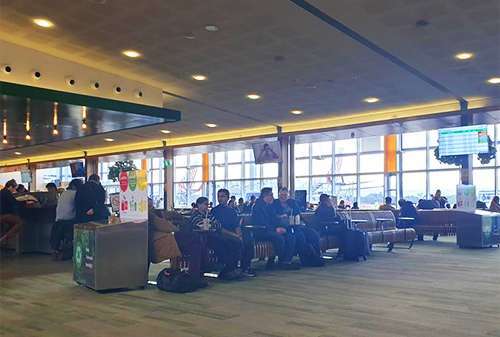 The next morning, Hobart reminded me how chilly it can get, just 5 degrees, although bathed in brilliant sunshine. I checked out of the Allurity, had a nice breakfast at Beaujangles in the mall and caught the SkyBus back to the airport. There was a long line to get through security but it moved quickly and the terminus itself was not at all crowded.
The next morning, Hobart reminded me how chilly it can get, just 5 degrees, although bathed in brilliant sunshine. I checked out of the Allurity, had a nice breakfast at Beaujangles in the mall and caught the SkyBus back to the airport. There was a long line to get through security but it moved quickly and the terminus itself was not at all crowded.
In no time, I was on the plane winging my way back to Sydney, glad I’d sprung the extra few dollars for the leg room of an emergency exit seat. From the airport, I took the train south and was back in my Corrimal home before 6pm on Friday.
Since then, I’ve thought about how soon I can get back to Hobart. This trip was, of course, a special event not only to commemorate Jean and Bernard but also to catch up with friends who don’t even live in Hobart now.
Even so, I felt – and still feel – a great affection for the place itself. I had been warned that Hobart had changed a great deal since I’d left but the overwhelming sense I had was one of familiarity and homecoming. Frankly, I think Wollongong has changed a lot more in the 17 years I’ve lived in its northern satellite suburb than Hobart has in 30 years.
Working from my hotel room, it occurred to me that I could do what I do as easily from Hobart as from Corrimal. I’ve been fortunate to have loved living in Sydney: the early years in Paddington, Darlinghurst and Surry Hills, and then with Hazel in Woollahra, Bronte and Lilyfield after we moved from Newcastle, and then on to raise our children in wonderful Corrimal.
Still, I could see myself living in Hobart again. Maybe, just maybe, you can go home again.
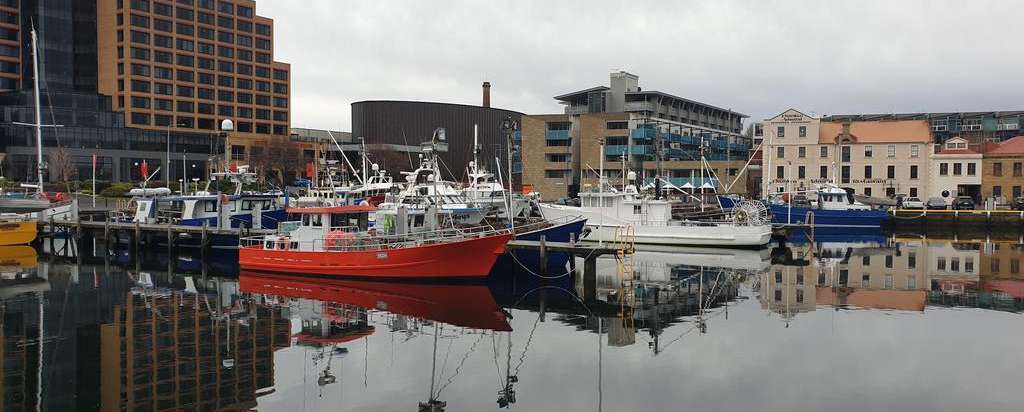
Just read this Ricky. Was with you all the way. So many memories, and of course so much about you I didn’t know.
Weren’t we lucky to have spent our ‘formative’ years in Hobart – with Pidds, a Noreen, an Adam and TUK… I remember walking home after nights sitting cross-legged on carpet floors, nights full of pizza, wine and ciggies, laughter, stories, (charades), instant coffee and singing in harmony, or enjoying the Pidds singing in harmony…
I can’t even put into words all the emotions I feel reading this, and looking at the photos.
mx
Just chanced upon your story. Beautifully crafted. The island makes for close and parallel lives. I knew Colin Pidd at Uni, and Hasenkam’s brother Mark was a very good friend at High School. Cabbage’s brother David, well known but self destructed